Repulsion - Study guides, Study notes & Summaries
Looking for the best study guides, study notes and summaries about Repulsion? On this page you'll find 653 study documents about Repulsion.
Page 2 out of 653 results
Sort by
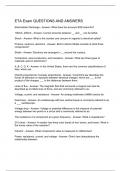
-
ETA Exam QUESTIONS AND ANSWERS
- Exam (elaborations) • 4 pages • 2023
- Available in package deal
-
- R188,56
- 1x sold
- + learn more
Electrostatic Discharge - Answer- What does the acronym ESD stand for? 100mA, 200mA - Answer- Current amounts between __ and __ can be lethal. Shock - Answer- What is the number one concern in regards to electrical safety? Protons, neutrons, electrons - Answer- Bohr's Atomic Model consists of what three components? Shells - Answer- Electrons are arranged in __ around the nucleus. Conductors, semi-conductors, and insulators - Answer- What are three types of materials used in elect...
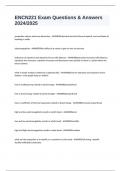
-
ENCN221 Exam Questions & Answers 2024/2025
- Exam (elaborations) • 28 pages • 2024
- Available in package deal
-
- R188,56
- + learn more
ENCN221 Exam Questions & Answers 2024/2025 properties valence electrons determine - ANSWERSchemical electrical thermal optical, and contribute to bonding in solids electronegativity - ANSWERSthe ability of an atom to gain or lose an electron behaviour of repulsive and attractive forces with distance - ANSWERSattraction increases with distance, repulsion also increases. repulsion increases and decreases more quickly so there is a point where the forces balance what is elastic modulu...
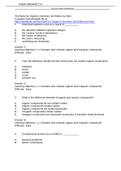
-
Test Bank for Organic Chemistry 3rd Edition by Klein
- Exam (elaborations) • 76 pages • 2022
-
- R269,45
- 2x sold
- + learn more
Test Bank for Organic Chemistry 3rd Edition by KleinChemical reactions occur as a result of __________ A. the attraction between opposite charges. B. the nucleus–nucleus interactions. C. the motion of electrons. D. like atoms interacting. E. combining two chemicals.Chemical reactions occur as a result of __________ A. the attraction between opposite charges. B. the nucleus–nucleus interactions. C. the motion of electrons. D. like atoms interacting. E. combining two chemicalsWhat is the diffe...
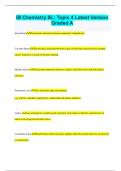
-
IB Chemistry SL: Topic 4 Latest Version Graded A
- Exam (elaborations) • 30 pages • 2024
- Available in package deal
-
- R188,56
- + learn more
IB Chemistry SL: Topic 4 Latest Version Graded A Ionic Bond Electrostatic attraction between oppositely charged ions Covalent Bond Electrostatic attraction between a pair of electrons and positively charged nuclei, formed as a result of electron sharing Metallic Bond Electrostatic attraction between a lattice of positive ions and delocalized electrons Polyatomic ions ions with more than one element e.g. CaCO3, Al(OH)3, Mg(NO3)2, (NH4)2SO4, Ba3PO4, LiHCO3 Lattice ions arran...
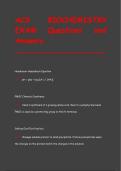
-
ACS BIOCHEMISTRY EXAM Questions and Answers
- Exam (elaborations) • 61 pages • 2024
- Available in package deal
-
- R242,48
- + learn more
Henderson-Hasselbach Equation Ans- pH = pKa + log ([A-] / [HA]) FMOC Chemical Synthesis Ans- Used in synthesis of a growing amino acid chain to a polystyrene bead. FMOC is used as a protecting group on the N-terminus. Salting Out (Purification) Ans- Changes soluble protein to solid precipitate. Protein precipitates when the charges on the protein match the charges in the solution. Size-Exclusion Chromatography Ans- Separates sample based on size with smaller molecules eluting later. ...
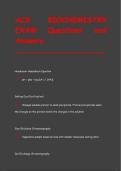
-
ACS BIOCHEMISTRY EXAM Questions and Answers
- Exam (elaborations) • 35 pages • 2024
- Available in package deal
-
- R224,51
- + learn more
Henderson-Hasselbach Equation Ans- pH = pKa + log ([A-] / [HA]) Salting Out (Purification) Ans- Changes soluble protein to solid precipitate. Protein precipitates when the charges on the protein match the charges in the solution. Size-Exclusion Chromatography Ans- Separates sample based on size with smaller molecules eluting later. Ion-Exchange Chromatography Ans- Separates sample based on charge. CM attracts +, DEAE attracts -. May have repulsion effect on like charges. Salt or acid ...
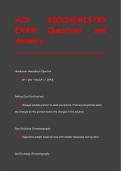
-
ACS BIOCHEMISTRY EXAM Questions and Answers
- Exam (elaborations) • 25 pages • 2024
- Available in package deal
-
- R206,53
- + learn more
Henderson-Hasselbach Equation Ans- pH = pKa + log ([A-] / [HA]) Salting Out (Purification) Ans- Changes soluble protein to solid precipitate. Protein precipitates when the charges on the protein match the charges in the solution. Size-Exclusion Chromatography Ans- Separates sample based on size with smaller molecules eluting later. Ion-Exchange Chromatography Ans- Separates sample based on charge. CM attracts +, DEAE attracts -. May have repulsion effect on like charges. Salt or acid ...
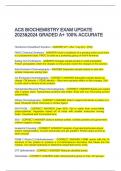
-
ACS BIOCHEMISTRY EXAM UPDATE 2023&2024 GRADED A+ 100% ACCURATE
- Exam (elaborations) • 19 pages • 2023
-
- R215,52
- + learn more
ACS BIOCHEMISTRY EXAM UPDATE 2023&2024 GRADED A+ 100% ACCURATE Henderson-Hasselbach Equation - ANSWER pH = pKa + log ([A-] / [HA]) FMOC Chemical Synthesis - ANSWER Used in synthesis of a growing amino acid chain to a polystyrene bead. FMOC is used as a protecting group on the N-terminus. Salting Out (Purification) - ANSWER Changes soluble protein to solid precipitate. Protein precipitates when the charges on the protein match the charges in the solution. Size-Exclusion Chromatography -...
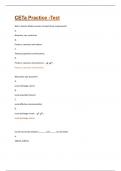
-
CETa Practice -Test Questions And Answers Rated A+ New Update Assured Satisfaction
- Exam (elaborations) • 32 pages • 2024
-
- R175,98
- + learn more
Bohr's Atomic Model consists of what three components? A. Neutrons, ion, neutrinos B. Protons, neutrons and cations C. Tachyons gravitons and electrons D. Protons, neutrons and electrons - D. Protons, neutrons and electrons What does LEC stand for? A. Local exchange carrier B. Local essential channel C. Local effective communication D. Local exchange circuit - A. Local exchange carrier Current amounts between ______ and _____ can be lethal. A. 100mA, 200mAB. 10mA, 33.3mA ...
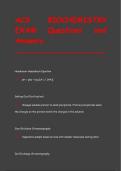
-
ACS BIOCHEMISTRY EXAM Questions and Answers
- Exam (elaborations) • 42 pages • 2024
- Available in package deal
-
- R242,48
- + learn more
Henderson-Hasselbach Equation Ans- pH = pKa + log ([A-] / [HA]) Salting Out (Purification) Ans- Changes soluble protein to solid precipitate. Protein precipitates when the charges on the protein match the charges in the solution. Size-Exclusion Chromatography Ans- Separates sample based on size with smaller molecules eluting later. Ion-Exchange Chromatography Ans- Separates sample based on charge. CM attracts +, DEAE attracts -. May have repulsion effect on like charges. Salt or acid ...

Do you wonder why so many students wear nice clothes, have money to spare and enjoy tons of free time? Well, they sell on Stuvia! Imagine your study notes being downloaded a dozen times for R250 each. Every. Single. Day. Discover all about earning on Stuvia


